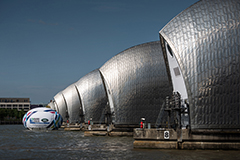Thames Flood Barrier
The Thames Barrier is the world's second-largest movable flood barrier (after the Oosterscheldekering in the Netherlands) and is located downstream of central London, United Kingdom. Operational since 1982, its purpose is to prevent the floodplain of all but the easternmost boroughs of Greater London from being flooded by exceptionally high tides and storm surges moving up from the North Sea. When needed, it is closed (raised) during high tide; at low tide it can be opened to enhance the river's flow towards the sea.
Built approximately 3 km due east of the Isle of Dogs, its northern bank is in Silvertown in the London Borough of Newham and its southern bank is in the New Charlton area of the Royal Borough of Greenwich. The report of Sir Hermann Bondi on the North Sea flood of 1953 affecting parts of the Thames Estuary and parts of London was instrumental in the building of the barrier. More details
Built approximately 3 km due east of the Isle of Dogs, its northern bank is in Silvertown in the London Borough of Newham and its southern bank is in the New Charlton area of the Royal Borough of Greenwich. The report of Sir Hermann Bondi on the North Sea flood of 1953 affecting parts of the Thames Estuary and parts of London was instrumental in the building of the barrier. More details

